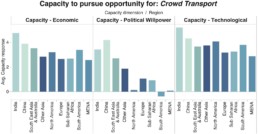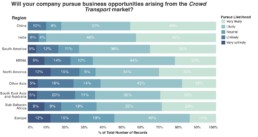Having the same possibilities for transport – only smarter and less resource demanding. This opportunity is about sharing our rides, both for personal and goods transport in a peer-2-peer system. It is the transport collaborative economy opportunity.
Would a factory owner invest in an expensive piece of machinery and then only use it for about an hour a day? Probably not, and with good reason. It just doesn’t pay off. If he really needs the job done, some subcontractor with the required machinery can do it and serve 6 or 7 other customers simultaneously.
It is a basic mechanism in the daily operation of businesses. Not every business that needs a brochure printed has their own offset-press. But in our private lives, we often invest in one of the most expensive pieces of machinery we can get – a car – and leave it in the garage for most of the day. When we do drive it, we often get stuck in traffic because everyone else in their underutilized cars also need to get to work at the same time. The crowd transport opportunity offers a way to make better use of cars to save time, money and resources.

Making Underused Assets Profitable
Today, many cars are driving with only one passenger and many lorries are driving half-empty. Furthermore, cars are one of the most underused assets, with many only circulating one hour a day. This opportunity lies in sharing our rides in a peer-2-peer system – both for personal and goods transport. It contributes to having more persons per car and more fully loaded freight transport which thereby reduces the emissions emitted per person.
Peer-to-peer transport implies low transaction costs because riders and passengers are connected using various GPS-based tools. These tools can allow citizens to share their identity, convey their position, and manage payments, thus facilitating a real-time connection between people looking for a ride with those who have a spare seat. Having an open platform where all have the possibility to join or provide a service will warrant a widely used system and thereby lower the number of cars driving around more than half empty. In fact, one car-sharing car can replace up to 13 privately owned vehicles. This will lower emissions and significantly reduce congestion.
Sharing Transport Economy
In recent years, we have seen the rise of sharing economy platforms, where people increasingly share products with others through online marketplaces. Sharing of services has emerged in several different sectors, including space rental, and transportation. Transportation has received significant investments in the recent years, but the potential is much greater. Approximately 8 percent of adults have participated in some form of automotive sharing, but just 1 percent have made their cars available so far.
Another initiative that has developed is businesses offering crowd transport to their employees with busses picking up of employees on their way to and from work. Equipped with Wi-Fi, coffee and meeting facilities, these busses make efficient use of working hours and sitting beside a colleague can strengthen cross-organization collaboration.
As one car-sharing car can replace up to 13 privately owned ones, pursuing a strategy to expand car-sharing promises significant gains in resource efficiency and reduced congestion. This opportunity will improve mobility for all people, since they can access activities without having to own a vehicle, while increasing the efficiency of transport.
Survey Findings
Taking journeys together is an opportunity to reduce emissions in a world where mobility is a fact of life. We have asked leaders around the world about their belief in this market opportunity as well as about their willingness and capability to pursue it. Here is a summary of our main findings from the data collected.

Crowd transport is a market opportunity which respondents from the governmental sector are very likely to pursue. Need for more efficient transportation of people and goods is also something which the public sector perceives to be very affected by. On a global scale, the survey shows that crowd transport is the market opportunity to reduce transport emissions with the highest levels of economic capacity to make it happen. For the countries classified as medium HDI, crowd transport is particularly preferred. It tells us that there is greater appetite for pursuing crowd transport in lower HDI countries than in higher.
The world seems divided when it comes to this market opportunity. North America, South East Asia & Australia and India, rate is very positively when assessed for impact both on society and the capacity to pursue. Oppositely, then China, the MENA region, and Europe, rate this market with less optimism. The South East Asian and Australian region stand out as they seem to see emissions from transport as an urgent issue to tackle, and the region perceives crowd transport as a viable avenue for addressing this risk. The regions rate crowd transport as a good opportunity to tackle the transport emissions challenges.

Business leaders in both China and India find that the countries have the capacities to pursue this opportunity with respect to the three dimensions of capacity measured: economic, technological, and political will power. In short, there is no persistent global trend when it comes to the opportunity of crowd transport; some parts of the world are ready to pursue it, whereas other regions are less excited about it. It can be expected that the public sector will be a driver of this opportunity.
This market was surveyed globally in 2015 by more than 5500 leaders from both the public and private sectors. The survey was conducted in collaboration with the research company YouGov. The survey results were originally published in the Global Opportunity Report 2016.

